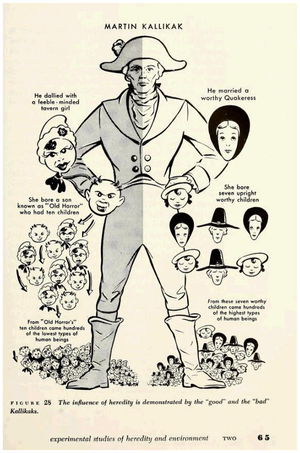When did we start sterilizing people in the United States
Context
Birth control and race suicide were already topics of public concern when, in the 1890s, Dr. Harry Sharp performed the first vasectomy in the United States at the Indiana State Reformatory (the salpingectomy had already been in practice in Europe for about a decade). Between 1899 and 1907, Sharp carried out some 200-800 male inmates at various institutions in Indiana.<Paul Julius,“‘Three Generations of Imbeciles Are Enough’: State Eugenic Sterilization Laws in American Thought and Practice,” Unpublished manuscript, Washington, D.C.: Walter Reed Army Institute of Research, 1965.</ref> While Sharpe believed the vasectomy could help cure degeneracy—especially excessive masturbation—proponents of the early eugenics movement recognized that his medical advancement opened the door for practical compulsory sterilization.
The eugenics movement has its origins in the middle of the 19th century. Charles Darwin’s theory of evolution—described in On the Origins of Species—provided a framework for physicians, social scientists, and polymaths alike to discuss some of the changes that were occurring in a rapidly industrializing world. People like Herbert Spencer used “Social Darwinism” to explain why giant corporations emerged (because they were better suited to) and why some people were poor while others grew immensely wealthy. Sociologists, like Robert Dugdale, were interested in how they could better society, and later eugenicists like Henry Goddard used intelligence tests to show that immigrants to the United States were less intelligent than native-born whites. Together these men applied science to the most vexing issue they saw: the inevitable degeneration of the white race due to immigration and unintelligent breeding.
First Sterilization Laws
In 1907, the State of Indiana passed what is recognized as the first eugenic sterilization law in the world. It articulated that heredity played an important role in the transmission of “crime, idiocy, and imbecility,” and allowed for the compulsory sterilization of those in state institutions who were considered “criminals,” “idiots,” “rapists,” and “imbeciles.” Several states followed suit and implemented their own sterilization laws. Sterilizations did occur under these early laws, but their numbers would pale in comparison to later years—in fact, Indiana temporarily halted sterilizations in 1909 after a change in leadership and funding concerns. Nevertheless, eugenicists tried to generate widespread support for compulsory sterilization in the 1910s by publishing degenerate family histories. Additionally, other sterilization proponents drafted Model Sterilization Laws that they hoped would survive the test of constitutionality. According to Paul Lombardo, by 1914, a total of “twelve states had enacted sterilization laws.”<http://www.eugenicsarchive.org/html/eugenics/essay8text.html.</ref>1920s Onward
Mass sterilization did not begin in earnest until the 1920s. California, for example had already sterilized some 2500 people before 1921, and had nearly doubled that number by 1928.<https://www.uvm.edu/~lkaelber/eugenics/CA/CA.html.</ref> Elsewhere, other States’ eugenic sterilization numbers rose as well--bolstered, in part, but the U.S. Supreme Court Decision Buck v. Bell (1927).
In 1924, Virginia created a new sterilization law for their State in order to reduce the burden on taxpayers for the cost of institutionalization. Carrie Buck became the first person sterilized under Virginia’s new law. She was 17 and had a child out of wedlock. The child was the product of a rape, but nevertheless was seen as evidence of Carrie’s moral degeneracy. Furthermore, Carrie’s mother was already a patient at the Virginia Colony for the Epileptic and Feebleminded—which also seemed to serve as evidence of bad lineage. Carrie’s defense challenged the validity of the law, and the case made its way to the U.S. Supreme Court where Justice Oliver Wendell Holmes upheld the constitutionality of Virginia’s sterilization law and uttered the infamous lines: “Three generations of imbeciles are enough.”
Carrie’s sterilization, and the U.S. Supreme Court’s ruling set a precedent that allowed for thousands of Americans to be sterilized under individual states’ legislation. The number sterilizations began to wane after World War II because of the negative publicity generated by the Nazi eugenic policy. Nevertheless, by the 1960s, some 60,000 Americans were sterilized. Approximately one third of those sterilizations were performed in California alone.
After WWII
Sterilizations were performed unevenly across the American population, and eugenicists typically targeted poor women and/or women of color. In the 1960s, in particular, welfare recipients became the target of sterilization. Despite legal challenges, sterilization continued through the 1970s.<Skinner v. Oklahoma, Reif v. Weinberger, for example.</ref> One of the most obvious cases that brought attention to the issue of 50 years of compulsory sterilization was Madrigal v. Quilligan (1978). In this class action suit, ethnic Mexican women sued obstetricians at Los Angeles County General Hospital for non-consensual sterilization. The plaintiffs were working-class Mexican origin women. In most of the cases, the women were coerced into agreeing to a tubal ligation while delivering children via caesarian section. Some women did not know what they were signing because the documents were in English and the patient spoke Spanish. In other instances the euphemism of having tubes "tied" suggested that they could be "untied," so women consented not recognizing the permanence, and in the worst instances, women were denied medical attention until forms had been signed. Ultimately, the court cited with the hospital, but as a result, more attention was brought to the fact that many states still had compulsory sterilization laws on the books--even if they were not necessarily being practiced anymore. Additionally, waiting periods and multilingual forms have also emerged in an attempt to correct the wrong that had been done to these women.
